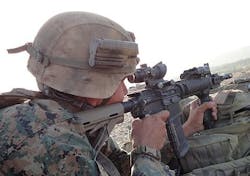3 companies to develop multispectral camera for helmets and weapon sights for DARPA
ARLINGTON, Va., 31 July 2013. Three U.S. electro-optics companies are working to develop a small multispectral camera to help infantrymen and small combat units detect, recognize, and identify battlefield threats in daylight, at night, in bad weather, or in smoke and dust for the U.S. Defense Advanced Research Projects Agency (DARPA) in Arlington, Va.
DARPA has awarded contracts to the DRS Technologies Reconnaissance, Surveillance, and Target Acquisition segment (DRS RSTA) in Dallas; Sensors Unlimited Inc. in Princeton, N.J.; and the Raytheon Co. Space and Airborne Systems segment in Goleta, Calif., for the Pixel Network for Dynamic Visualization (PIXNET) program, which seeks to reduce the size, weight, power, and cost (SWaP-C) of helmet- and infantry weapon-mounted situational-awareness cameras.
The contracts, awarded earlier this month, are worth $15.5 million to DRS RSTA, $8.9 million for Sensors Unlimited, and $8.6 million for Raytheon.
The DARPA PIXNET program also seeks to improve color fusion and image rendition for users to improve the infantryman's ability to detect and identify potential threats quickly and communicate crucial development to higher command authorities, as well as for on-site planning at the squad level, DARPA officials say.
Ultimately, the program seeks to develop helmet-mounted and clip-on camera systems that combine visible, near infrared, and infrared sensors into one system and combine the outputs. PIXNET technology would fuse multispectral information into a common image viewable on the warfighter display and sharable across units.
The three PIXNET contractors will try to develop enabling technologies for helmet-mounted cameras and clip-on weapon sights. Each camera type will be linked wirelessly to an Android smart phone for multi-band image fusion, data processing, and image display.
DARPA researchers say they expect the PIXNET cameras developed by DRS RSTA, Sensors Unlimited, and Raytheon to be network ready with a smart phone. The combination of a smart phone and the PIXNET camera is to enhance tactics, techniques, and procedures.
“Existing sensor technologies are a good jumping-off point, but PIXNET will require innovations to combine reflective and thermal bands for maximum visibility during the day or night, and then package this technology for maximum portability," says Nibir Dhar, DARPA program manager for PIXNET.
"What we really need are breakthroughs in aperture design, focal plane arrays, electronics, packaging and materials science," Dhar says. "Success will be measured as the minimization of size, weight, power and cost of the system and the maximization of functionality.”
For more information contact DRS RSTA online at www.drs.com/Products/RSTA; Sensors Unlimited at www.sensorsinc.com, Raytheon Space and Airborne Systems at www.raytheon.com, or DARPA at www.darpa.mil.
